NATO allocated the new reporting name 'Fulcrum-C' for aircraft fitted with a bulged and extended spine, which reportedly houses both fuel and avionics, and which may also be applied through retrofit. Internal fuel is increased by provision of larger No. 1 fuel tank, though different sources disagree as to the size of the increase (75, 130, 175 or 240 litres/20, 34, 46 or 63 US gal, according to Mikoyan documents). Soviet sources suggest that the 'Fulcrum-C' is still simply designated MiG-29, although the nickname 'Gorbatov' (hunchback) is commonly used.
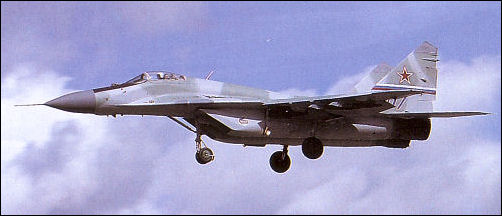 One of the MiG-29S prototypes, this aircraft has a modified flight control system and upgraded radar, plus provision for Western avionics and underwing fuel tanks. A staged programme of modifications will allow the aircraft to carry up to 4000 kg of external stores. An inflight-refuelling probe and laser-, TV- and radar-guided ASMs will be added from 1995.
One of the MiG-29S prototypes, this aircraft has a modified flight control system and upgraded radar, plus provision for Western avionics and underwing fuel tanks. A staged programme of modifications will allow the aircraft to carry up to 4000 kg of external stores. An inflight-refuelling probe and laser-, TV- and radar-guided ASMs will be added from 1995.
The first 'fatbacked' MiG-29 was 9-13, the second pre-production aircraft, which first flew on 23 December 1980, in the hands of V.M. Gorbunov. At one time the 'Fulcrum-C' seemed to be slowly replacing the 'Fulcrum-A' in VVS service, bu the two types continued in production alongside one another and often serve in the same units (occasionally with the very early ventral-finned MiG-29s). Pilots report that apart from endurance, there is no difference in flying/operating characteristics, although some sources suggest that the 'Fulcrum-C' has an enhanced ground attack capability and/or provision for an active jammer. Certainly the 9-13 has redesigned wingtips which appear to accomodate new RWR antennas. No 'hunchbacked' 'Fulcrum-Cs' have been exported yet, though Malaysia's MiG-29s may prove to be based on the 'Fulcrum-C'.
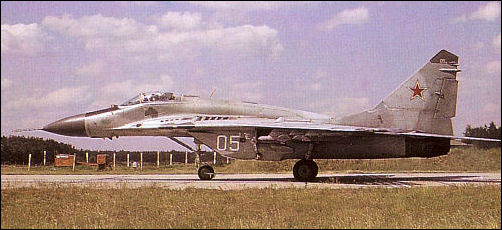 The unique contours of the 'Fulcrum-C's enlarged fuselage spine led to the allocation of new NATO reporting name, although the OKB designation is unchanged.
The unique contours of the 'Fulcrum-C's enlarged fuselage spine led to the allocation of new NATO reporting name, although the OKB designation is unchanged.
The 9-13 forms the basis of the improved MiG-29S (9-13S), which was designed as an increased-capability version of the standard MiG-29. According to Mikoyan, the MiG-29S represents "what happened when we squeezed all we could from the basic MiG-29 airframe." The new variant has a new modified flight control system, using small computers to improve stability and controllability, and the control surfaces have greater deflection. Alpha and g limits are increased. All MiG-29S features can be incorporated by upgrading existing 'Fulcrum-Cs', and MAPO is aggressively marketing a similar upgrade for export 'Fulcrum-As'.
The MiG-29S introduces revised radar/weapons system algorithms and software (and it is believed that processing capacity has been increased) to allow for the simultaneous tracking and engagement of multiple targets. The modified radar is redesignated N-019M. Operational capability has been enhanced by fitting a new sighting system, and more recently by making provision for the active homing AAM-AE 'AMRAAMski'. The first MiG-29S made its maiden flight during 1984, and three prototypes were followed by new production aircraft and conversions. Two polk (squadrons) are in service.
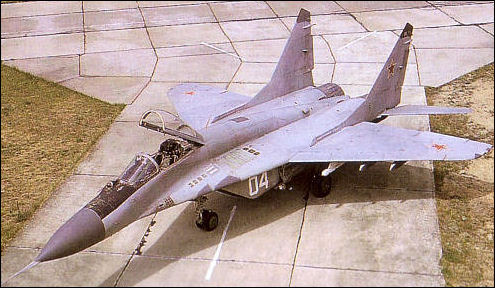 Although the spine of the 'Fulcrum-C' is considerably enlarged, it contains only 75-240 litres of extra fuel.
Although the spine of the 'Fulcrum-C' is considerably enlarged, it contains only 75-240 litres of extra fuel.
The designation MiG-29SE has been applied to an export version of the MiG-29S. This has a slightly downgraded radar (the N-019ME) which retains multiple-target tracking and which may give compatibility with AAM-AE. An aircraft displayed at Le Bourget in June 1993 was not a MiG-29SE, but was a standard MiG-29 variant plumbed for the carriage of underwing fuel tanks, but this is untrue, since many Soviet 'Fulcrum-As' have been seen carrying these for ferry flights. The MiG-29S may, however, be the first variant stressed to carry underwing tanks in combat, or to have provision for extra pylons (like the MiG-29M and the MiG-29K) to allow tanks to be carried without sacrificing weapons, and is the first export model offered with underwing tanks. External warload is doubled by the simple expedient of restressing the inner underwing pylons to carry up to four 500-kg (1,102-lb) bombs in side-by-side tandem pairs.
The end of the Cold War has led to a dramatic down-scaling of MiG-29 production, both for the VVS and for the export customers. Production in Moscow (at the Labour Banner factory) and in Nizhny Novograd continues at a very low rate, adding to a June 1993 stockpile which totalled about 100 unsold aircraft. A July 1993 Malaysian order for the MiG-29 may have been for some of these aicraft upgraded to MiG-29SE standards, or for MiG-29Ms. The 18 aircraft on order include some two-seaters (perhaps as many as six). Hungary's MiG-29s have been described as MiG-29Ss by some sources, but are actually standard 'Fulcrum-As'.
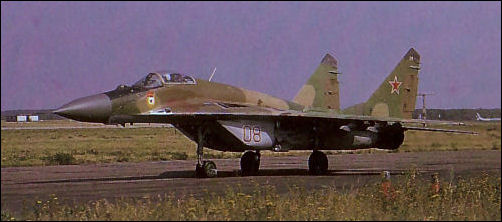 The brown and green ground attack colour scheme worn by some Russian and Ukrainian MiG-29s (mainly 'Fulcrum-Cs', but including some early ventral-finned 'Fulcrum-As') is very similar to that applied to Czech and East German air force aircraft. This Russian 'Fulcrum-C' carries a Guards badge, perhaps indicating previous service at Kubinka, but was photographed at Zhukhovskii, where it serves the LII Gromov Flight Research Centre as a development and test aircraft.
The brown and green ground attack colour scheme worn by some Russian and Ukrainian MiG-29s (mainly 'Fulcrum-Cs', but including some early ventral-finned 'Fulcrum-As') is very similar to that applied to Czech and East German air force aircraft. This Russian 'Fulcrum-C' carries a Guards badge, perhaps indicating previous service at Kubinka, but was photographed at Zhukhovskii, where it serves the LII Gromov Flight Research Centre as a development and test aircraft.
SPECIFICATION
Mikoyan MiG-29S
generally similar to the Mikoyan MiG-29 'Fulcrum-A' except in the following
particulars:
Weights: normal take-off weight 15300 kg (33,730 lb): maximum take-off weight 19700 kg (42,680 lb)
Fuel and load: internal fuel 4440-4540 litres (976-998 US gal), external fuel 3,800 litres (1,004 US gal): maximum ordnance load 4000 kg (8,818 lb)
Range: ferry range 2900 km (1,566 nm; 1,802 miles) with three drop tanks
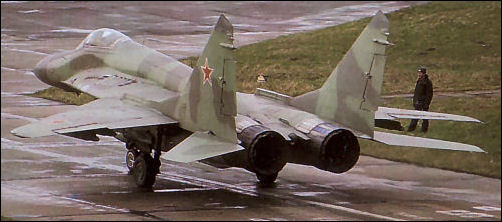
This unusual two-tone green camouflage, seen on a pair of of MiG-29s (this one a 'Fulcrum-C') departing from Ribnitz-Damgarten during May 1994, may be the latest MiG-29 fighter-bomber colour scheme, or may have been entirely experimental and applied at unit level. One of the 733rd IAP's three squadrons was believed to have a primary fighter-bomber role.
